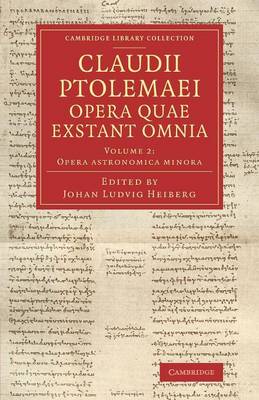Cambridge Library Collection - Classics
1 primary work • 5 total works
Volume 1
Best known for his 1906 discovery of lost texts in the Archimedes Palimpsest, Danish scholar Johan Ludvig Heiberg (1854–1928), professor of classical philology at Copenhagen, published numerous editions of ancient mathematicians, including Archimedes and Apollonius of Perga (also reissued in this series). Between 1898 and 1907, he published in three parts the extant astronomical works of Ptolemy, active in second-century Alexandria. The Ptolemaic system, his geocentric model of the universe, prevailed in the Islamic world and in medieval Europe until the time of Copernicus. Volume 2, published in 1907, contains a brief preface and a substantial prolegomena in Latin, followed by the Greek text of Ptolemy's shorter astronomical works, including Phaeis aplanon asteron, a treatise on the phenomena of the fixed stars, and Hypotheseis ton planomenon, his planetary hypotheses representing the most influential statement of his geocentric model, provided here with a facing-page translation into German.
Best known for his 1906 discovery of lost texts in the Archimedes Palimpsest, Danish scholar Johan Ludvig Heiberg (1854-1928), professor of classical philology at Copenhagen, published numerous editions of ancient mathematicians, including Archimedes and Apollonius of Perga (also reissued in this series). Between 1898 and 1907, he published in three parts the extant astronomical works of Ptolemy, active in second-century Alexandria. The Ptolemaic system, his geocentric model of the universe, prevailed in the Islamic world and in medieval Europe until the time of Copernicus. Volume 1 appeared in two parts. Part 1 (1898) contains Books 1-6 of Ptolemy's major astronomical treatise, the Almagest. Part 2 (1903) contains Books 7-13. Volume 2 (1907) contains a substantial prolegomena in Latin, followed by the Greek text of Ptolemy's shorter astronomical works, notably Hypotheseis ton planomenon, his planetary hypotheses, provided here with a facing-page translation into German.
Claudii Ptolemaei opera quae exstant omnia: Volume 1, Syntaxis mathematica, Part 1, Libros I-VI
by Ptolemy
Published 5 October 2014
Best known for his 1906 discovery of lost texts in the Archimedes Palimpsest, Danish scholar Johan Ludvig Heiberg (1854-1928), professor of classical philology at Copenhagen, published numerous editions of ancient mathematicians, including Archimedes and Apollonius of Perga (also reissued in this series). Between 1898 and 1907, he published in three parts the extant astronomical works of Ptolemy, active in second-century Alexandria. The Ptolemaic system, his geocentric model of the universe, prevailed in the Islamic world and in medieval Europe until the time of Copernicus. This first part of Volume 1, published in 1898, contains a brief Latin preface and the Greek text of Books 1-6 of Ptolemy's major astronomical treatise, known as the Almagest. It demonstrates how to use astronomical observations to construct cosmological models and includes tables that make it possible for celestial phenomena to be calculated for arbitrary dates.
Claudii Ptolemaei opera quae exstant omnia: Volume 1, Syntaxis mathematica, Part 2, Libros VII-XIII
by Ptolemy
Published 5 October 2014
Best known for his 1906 discovery of lost texts in the Archimedes Palimpsest, Danish scholar Johan Ludvig Heiberg (1854-1928), professor of classical philology at Copenhagen, published numerous editions of ancient mathematicians, including Archimedes and Apollonius of Perga (also reissued in this series). Between 1898 and 1907, he published in three parts the extant astronomical works of Ptolemy, active in second-century Alexandria. The Ptolemaic system, his geocentric model of the universe, prevailed in the Islamic world and in medieval Europe until the time of Copernicus. This second part of Volume 1, published in 1903, contains a brief Latin preface and the Greek text of Books 7-13 of Ptolemy's major astronomical treatise, known as the Almagest. It demonstrates how to use astronomical observations to construct cosmological models and includes tables that make it possible for celestial phenomena to be calculated for arbitrary dates.
Claudii Ptolemaei opera quae exstant omnia: Volume 2, Opera astronomica minora
by Ptolemy
Published 5 December 2014
Best known for his 1906 discovery of lost texts in the Archimedes Palimpsest, Danish scholar Johan Ludvig Heiberg (1854-1928), professor of classical philology at Copenhagen, published numerous editions of ancient mathematicians, including Archimedes and Apollonius of Perga (also reissued in this series). Between 1898 and 1907, he published in three parts the extant astronomical works of Ptolemy, active in second-century Alexandria. The Ptolemaic system, his geocentric model of the universe, prevailed in the Islamic world and in medieval Europe until the time of Copernicus. Volume 2, published in 1907, contains a brief preface and a substantial prolegomena in Latin, followed by the Greek text of Ptolemy's shorter astronomical works, including Phaeis aplanon asteron, a treatise on the phenomena of the fixed stars, and Hypotheseis ton planomenon, his planetary hypotheses representing the most influential statement of his geocentric model, provided here with a facing-page translation into German.

